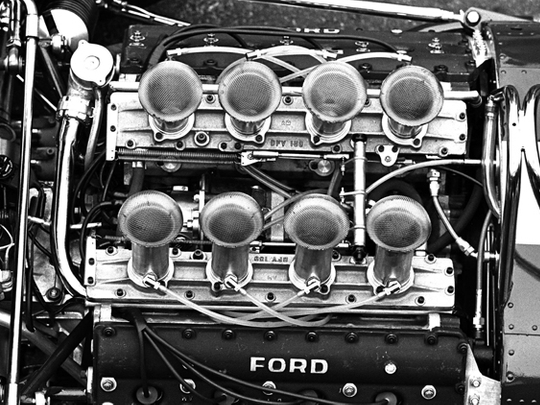
This week is a milestone for wheels' Legends, because we're finally legendarising an engine. And there could only be one motor to kick this off: Cosworth's four-valves-per-cylinder 3.0-litre V8. You may have heard of it more commonly referred to as the venerable DFV.
There are many, many great V8s, but none as great as the dominant Cosworth unit that won in Formula 1, CART, Formula 3000, sportscar racing, Le Mans, and Indy.
It started winning in 1967, and kept on bringing the laurels home right into the Nineties. Its last win took place in 1983, when it was surrounded by turbocharged rivals, and it was still competitive in 1985 when Martin Brundle gave the DFV its F1 send-off.
How could this engine stay competitive for so long, winning a ridiculous dozen drivers' F1 championships and 10 constructors', especially amidst more powerful turbo adversaries? Well in case you didn't notice already, we did say it was a Cosworth engine. That's how.
But there's slightly more to our case for the DFV's legendary status. When Lotus commissioned this motor, the task seemed simple enough: a 90-degree 3.0-litre V8 (regulations, see) producing just over 400bhp at 9,000rpm. But by the end of its F1 career, the DFV produced well over 500 horsepower thanks to its remarkable flexibility and strength, revving to almost 12,000rpm.
Right at its debut at Holland's lightning-fast beach-side Zandvoort circuit, Graham Hill put a DFV on pole, before his team-mate Jim Clark blitzed the field to take the win. An era began. Everybody was scrambling to buy DFVs for the back of their cars.
The competing manufacturers like Ferrari, BRM, Honda and Eagle, designed units that were heavier, less reliable and not very open to technical progress.
The DFV kept evolving, and as a result stayed ahead of the competition for so many years. In 1969, every single F1 championship round was won by a DFV. Eventually the Cosworth motor took 155 GP wins.
Nothing else ever came close, but in the Eighties the arrival of 1.5-litre turbo engines meant the now-ancient DFV couldn't stay ahead.
Still, it was quite a run, and it will never be repeated again.
Timeline
Lotus 49 Right from the beginning, the DFV started winning, even grabbing pole position at its debut in the Netherlands.
McLaren M26 James Hunt ‘The Shunt' won the championship in monsoon conditions at Fuji in Japan, his DFV running strong all season long.
Lotus 72 Jochen Rindt's 72 was built around the engine, generating 20kph more on the straights with unchanged power figures.










